Click to tweet this: “Love Vietnamese broken rice pork chops? Recipe here: super easy step by step visual guide via @thangngo”
Recently, I was asked to edit a major assignment written by UWS student, Joseph Vo. It tracks his father, Tuan Anh Vo‘s love for that quintessential Vietnamese dish, com tam, sometimes translated as Vietnamese broken rice and pork chops. It also includes Mr Vo’s home-style com tam recipe, with a step by step visual guide produced by Joseph (at the end of this post).
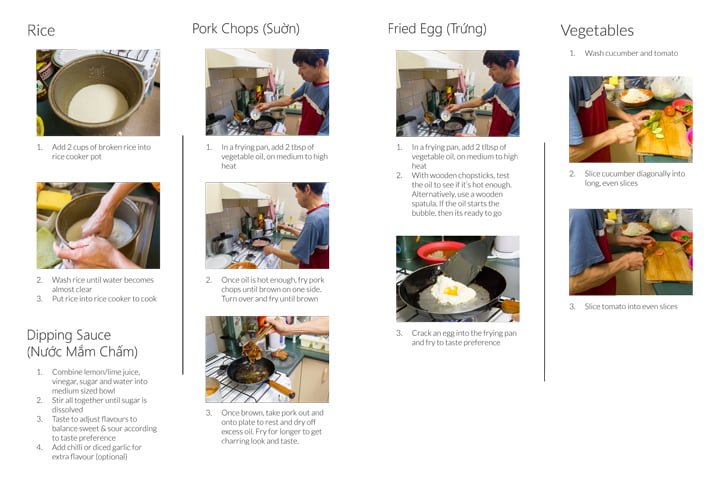
I loved it so much that I’ve asked Joseph to share his work with noodlies, Sydney food blog readers. I really hope you enjoy reading it as much as I did!
Com Tam (Vietnamese Broken Rice)
By Joseph Vo, edited by Thang Ngo
Com tam, or broken rice, is a Vietnamese dish made from rice with fractured rice grains. Tam refers to the broken rice grains, while com refers to cooked rice. Also known as com tam Sài Gòn as it is particularly served in southern Vietnam, Saigon, now known as Ho Chi Minh City.
This type of rice is named after the process, which created it; left over broken pieces of rice that Vietnamese rice farmers couldn’t sell, so they ate it themselves.
It is usually served with suon, (grilled marinated pork chops) plus bì (thinly shredded pork mixed with cooked and thinly shredded pork skin) over broken rice. The rice and meat are served with finely sliced cucumber, tomato and pickled vegetables, along with a cha trung hap (prawn paste cake also known as steamed pork and egg custard or pork meatloaf with egg), trung chien (fried egg), and grilled prawns.
It’s a dry dish; so typically, restaurants would serve this popular dish with a small bowl of nuoc cham (dipping sauce made from fermented fish sauce), as well as a small bowl of clear broth (canh) with garlic chives (to cleanse the throat).
A diner can customise his dish, for example, you can order com tam bì, which effectively leave out the cha trung egg meatloaf.
There are many other variations of this dish using different components. For example, one variation may include grilled pork and egg while another may have the pork but no egg. Or one may have shredded pork with pork skin while another may not.
The most complete version of com tam includes broken rice, shredded pork with pork skin, pork chop, egg, cha trung meatloaf with a serving of vegetables and pickled carrot and daikon, with serving of nuoc cham sauce on the side.
Uncooked com tam can be found in most Asian markets in the rice section.
This type of rice is named after the process, which created it; left over broken pieces of rice that Vietnamese rice farmers couldn’t sell, so they ate it themselves. It is very traditional and has a great texture wise, and probably not as scented as long grain jasmine rice.
Dad’s Experience
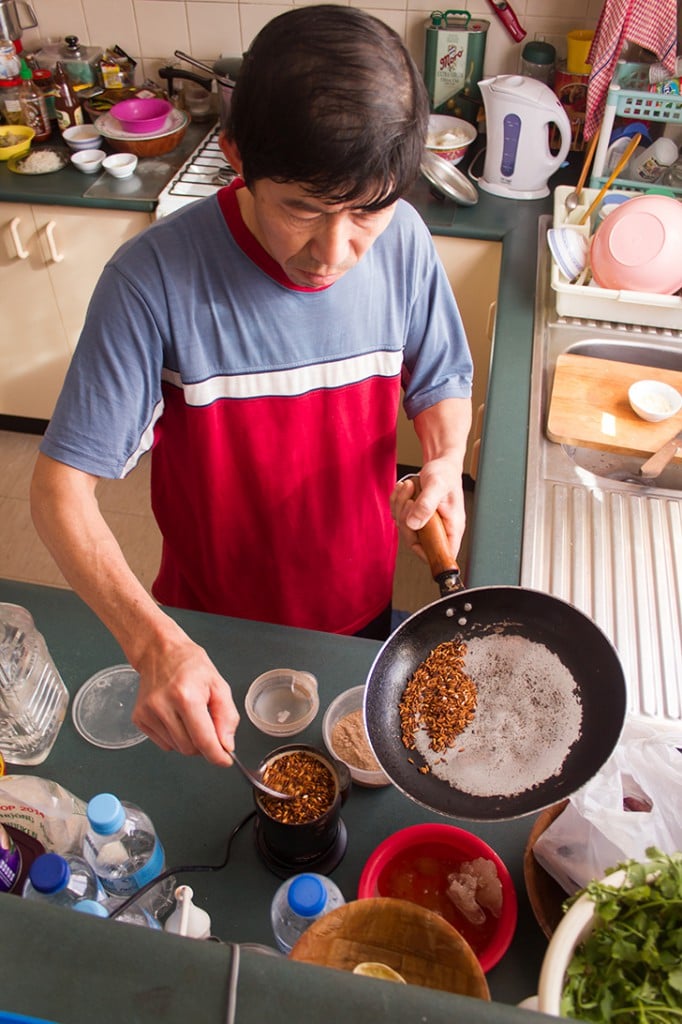
Then
Growing up in Vietnam, rice is a staple, which is in everyone’s diet and is available in every Vietnamese household. Rice comes in many different forms for different dishes that can be consumed during the day, from breakfast all the way through to dinner. Rice is used in both desserts and savoury dishes.
Now
When he eats out, he always orders his favourite Com Tam Bi Suon Trung (Broken Rice with Shredded Pork with Pork Skin, Pork Chop and Egg). He always prefers his egg sunny side up with the yolk still runny. He always says to the waiter that he wants his egg that way or he will send the dish back (he’s joking of course, but this effectively makes his point).
In The Kitchen
When I first came up to Dad to ask if he would cook his favourite Com Tam dish, he was like “What? What for?”
I then had to explain it was for my major project and that I was going to take photos of him with the lighting equipment that I was going to borrow from uni as he was cooking the dish. He was kind of reluctant at first but he eventually agreed.
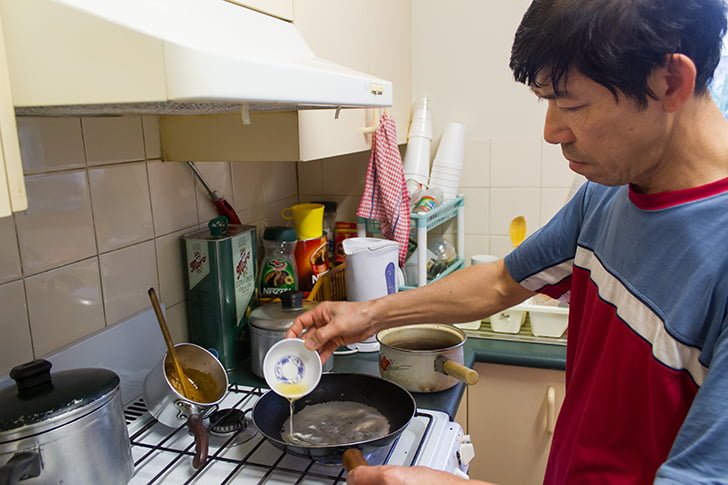
As he works during the second half of the week, there wasn’t much time to prepare ingredients but eventually he managed to get the ingredients together the day before the shoot. When it came to shoot day, I was nervous but was excited to begin. First, I had to set up the lighting equipment and camera set up ready for the shoot.
To make the process as flowing as possible, I started off with taking photos of the ingredients that were going to be used for the dish. Dad had to step out for a while so that gave me an opportunity to photograph all the ingredients and to plan out all the photo that needed to be taken to be used for this project.
When he came back home, I explained to him what I was going to be doing and what he was suppose to do, which was to cook just like normal and ignore me and pretend I wasn’t there.
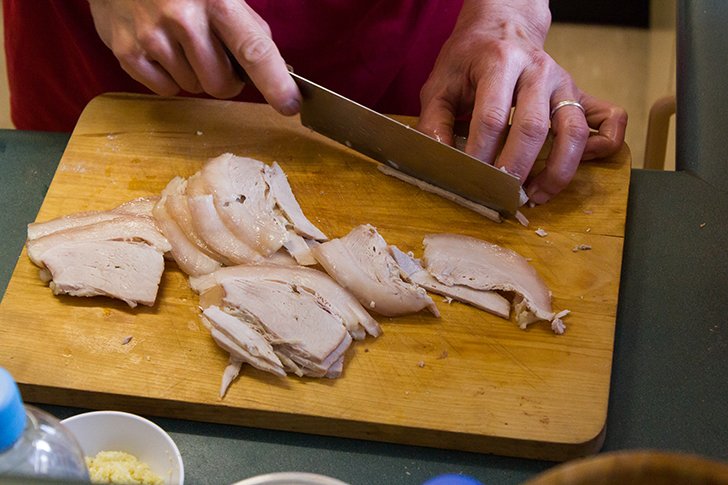
It was really insightful to see my dad cook his favourite dish. When he cooks food for dinner, I didn’t really notice how he is until I actually took notice during the shoot. When he cooks, he takes pride in what he does but works efficiently in an organised manner.
During the shoot, there were a lot of interruptions but nothing that caused a major disruption to cooking process. During the cooking process, there were a lot of things that were happening all at the same time and the complete dish was taking its form. Some elements weren’t created as they were already created prior to the shoot such as the Nuoc Mam Cham (Dipping sauce).

Dad has a different way of doing things but achieves the same result as if he followed the correct procedure. He works in the way that he is most comfortable with.
He doesn’t have much cooking skills but from his past experiences working in numerous take-away shops throughout the years, he has picked up a few tricks and methods here and there enhancing his knowledge and skillset.
Watching him cook was really inspiring, seeing his skills and techniques come out. One of his main strengths is his precision knife skills. They are incredibly accurate and very precise, the funny thing is that he can’t really cut thick slices of anything because he is too used to cutting in thin slices. It was really cool to see his knife skills in action, skills that talented chefs take years to master, skills that my dad has.
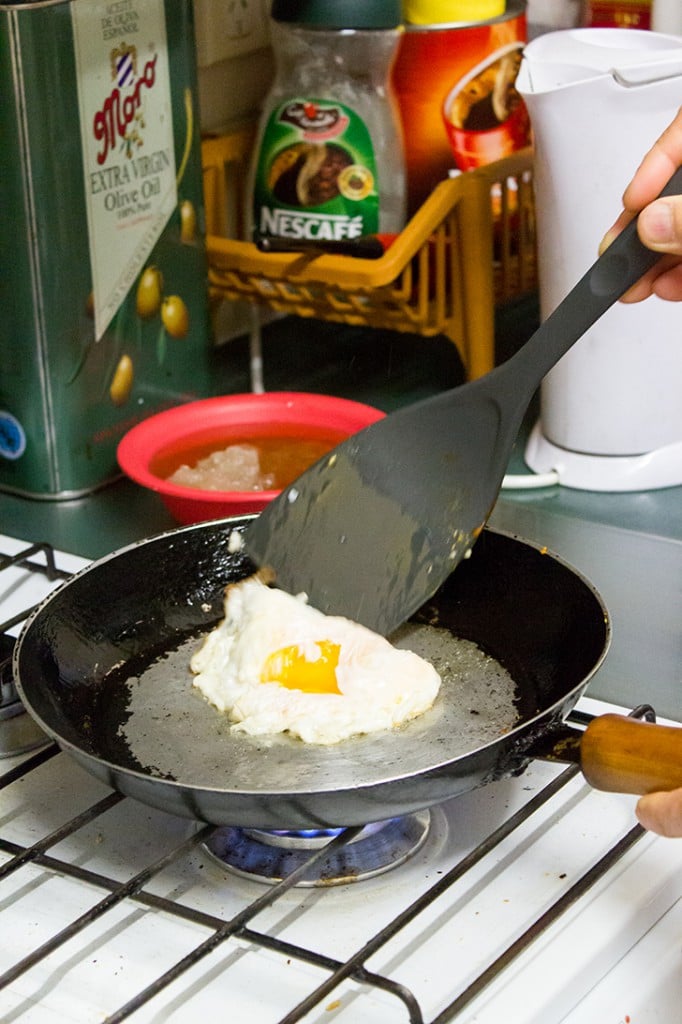
During the shoot, I was pointing out some suggestions on how to do certain elements but he brushed them off and kept saying, “I know, I know how to do it”. So I decided to keep mum and let him do this thing, the way he does it.
Some elements didn’t go according to plan but nonetheless the dish still came together in the end with a very satisfactory result. In the end, he didn’t get to try his creation after finishing the dish but instead had a taste afterwards.
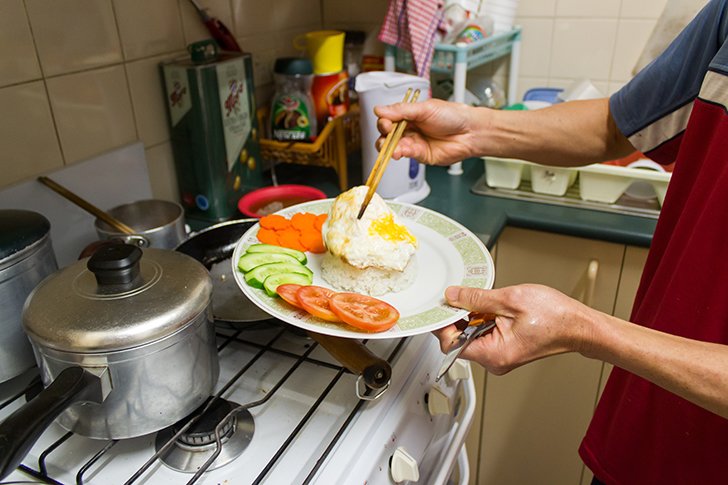
Com Tam Recipe
By Tuan Anh Vo
Full recipe further below or download the step-by-step visual guide below.
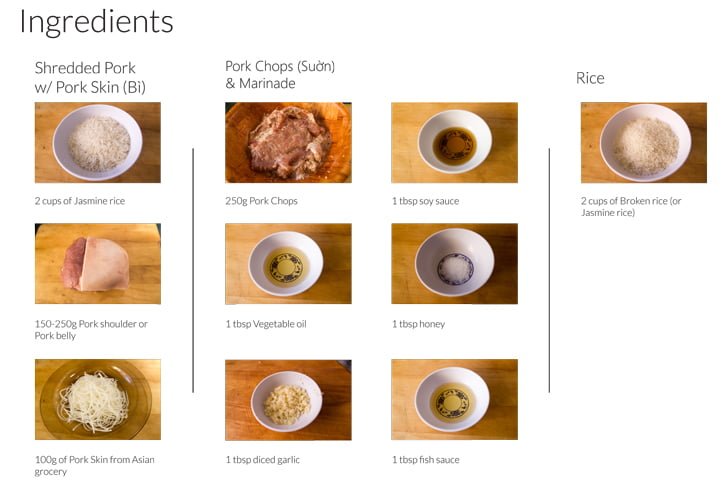
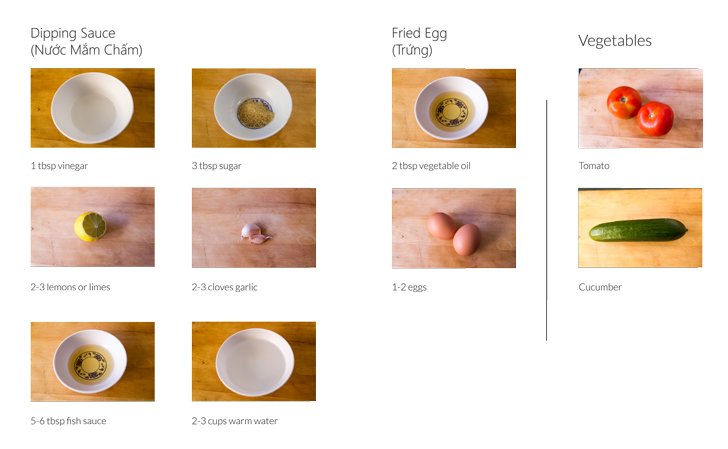
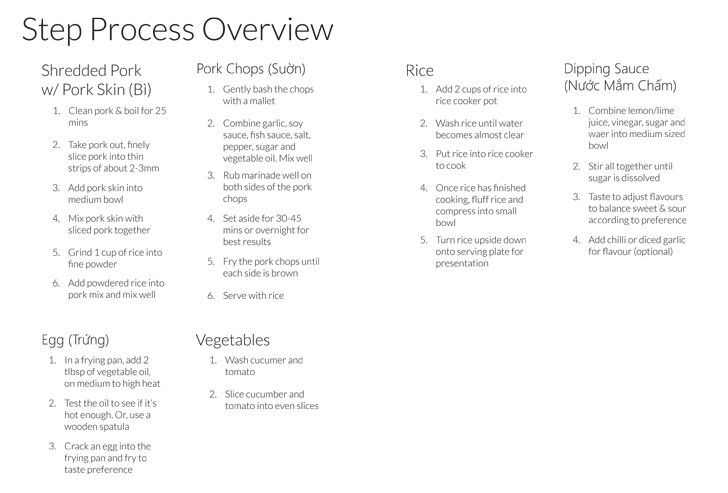
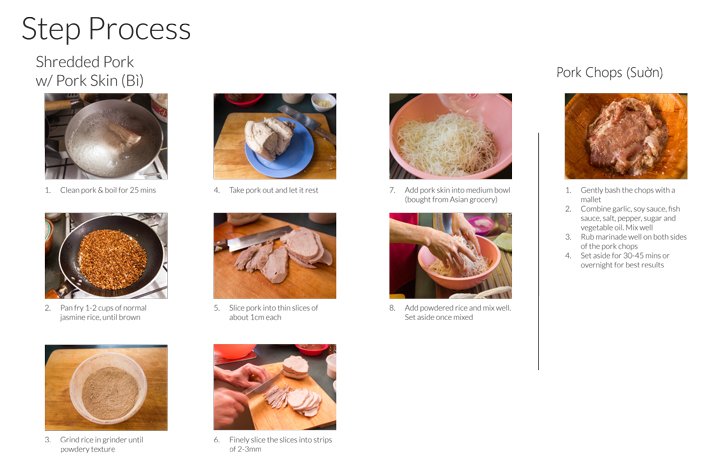

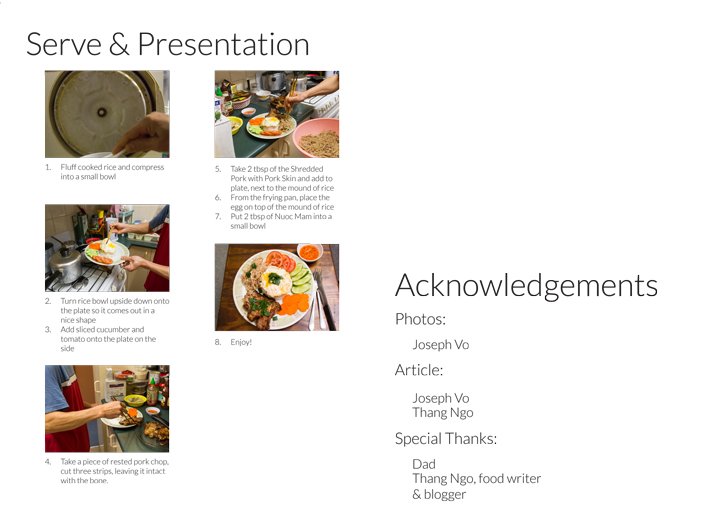
Ingredients
Shredded Pork w/ Pork Skin (Bì)
• 2 cups of Jasmine rice
• 150-250g Pork shoulder or Pork belly
• 100g of Pork Skin from Asian grocery
Pork Chops (Suờn) & Marinade
• 250g Pork Chops
• 1 tbsp Vegetable oil
• 1 tbsp diced garlic
• 1 tbsp soy sauce
• 1 tbsp honey
• 1 tbsp fish sauce
Rice
• 2 cups of Broken rice (or Jasmine rice)
Dipping Sauce (Nước Mắm Chấm)
• 1 tbsp vinegar
• 2-3 lemons or limes
• 5-6 tbsp fish sauce
• 3 tbsp sugar
• 2-3 cloves garlic
• 2-3 cups warm water
Fried Egg (Trứng)
• 2 tbsp vegetable oil
• 1-2 eggs
Vegetables
• Tomato
• Cucumber
Method
Shredded Pork w/ Pork Skin (Bì)
1. Clean pork & boil for 25 mins
2. Pan fry 1-2 cups of normal jasmine rice, until brown
3. Grind rice in grinder until powdery texture
4. Take pork out and let it rest
5. Slice pork into thin slices of about 1cm each
6. Finely slice the slices into strips of 2-3mm
7. Add pork skin into medium bowl (bought from Asian grocery)
8. Add powdered rice and mix well. Set aside once mixed
Pork Chops (Suờn)
1. Gently bash the chops with a mallet
2. Combine garlic, soy sauce, fish sauce, salt, pepper, sugar and vegetable oil. Mix well
3. Rub marinade well on both sides of the pork chops
4. Set aside for 30-45 mins or overnight for best results
5. In a frying pan, add 2 tbsp of vegetable oil, on medium to high heat
6. Once oil is hot enough, fry pork chops until brown on one side. Turn over and fry until brown
7. Once brown, take pork out and onto plate to rest and dry off excess oil. Fry for longer to get charring look and taste.
Rice
1. Add 2 cups of broken rice into rice cooker pot
2. Wash rice until water becomes almost clear
3. Put rice into rice cooker to cook
Pork Chops (Suờn)
1. In a frying pan, add 2 tbsp of vegetable oil, on medium to high heat
2. Once oil is hot enough, fry pork chops until brown on one side. Turn over and fry until brown
3. Once brown, take pork out and onto plate to rest and dry off excess oil. Fry for longer to get charring look and taste.
Dipping Sauce (Nước Mắm Chấm)
1. Combine lemon/lime juice, vinegar, sugar and water into medium sized bowl
2. Stir all together until sugar is dissolved
3. Taste to adjust flavours to balance sweet & sour according to taste preference
4. Add chilli or diced garlic for extra flavour (optional)
Fried Egg (Trứng)
1. In a frying pan, add 2 tlbsp of vegetable oil, on medium to high heat
2. With wooden chopsticks, test the oil to see if it’s hot enough. Alternatively, use a wooden spatula. If the oil starts the bubble, then its ready to go
3. Crack an egg into the frying pan and fry to taste preference
Vegetables
1. Wash cucumber and tomato
2. Slice cucumber diagonally into long, even slices
3. Slice tomato into even slices
Serve & Presentation
1. Fluff cooked rice and compress into a small bowl
2. Turn rice bowl upside down onto the plate so it comes out in a nice shape
3. Add sliced cucumber and tomato onto the plate on the side
4. Take a piece of rested pork chop, cut three strips, leaving it intact with the bone.
5. Take 2 tbsp of the Shredded Pork with Pork Skin and add to plate, next to the mound of rice
6. From the frying pan, place the egg on top of the mound of rice
7. Put 2 tbsp of Nuoc Mam into a small bowl
8. Enjoy!
Com tam recipe by Tuan Anh Vo, Story and photography by Joseph Vo, edited by Thang Ngo.

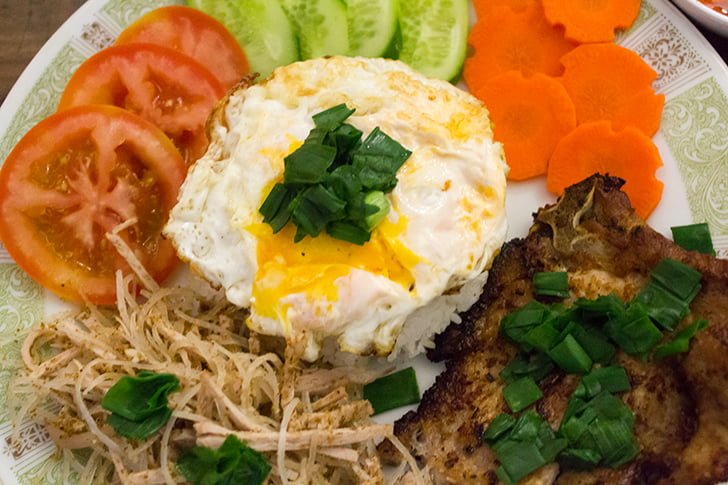
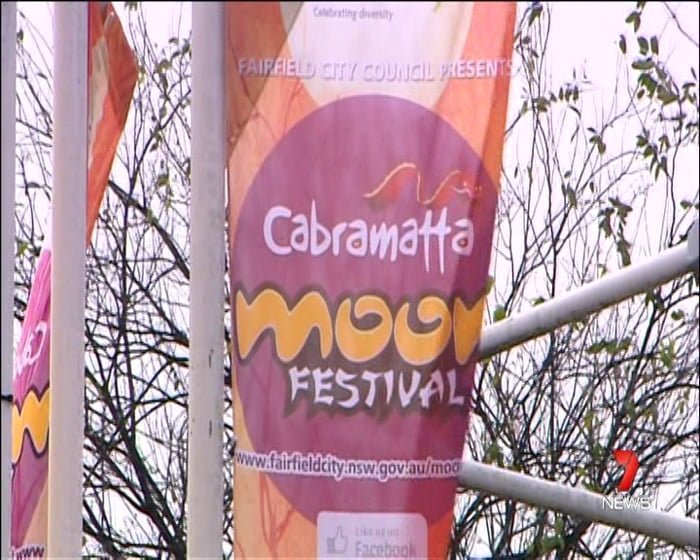

Excellent….thank you….will do it very soon
Very delicious recipe!! loved it.
This is awesome, thank you for going to the effort!
This is fantastic, exactly how my dad makes it for me 🙂